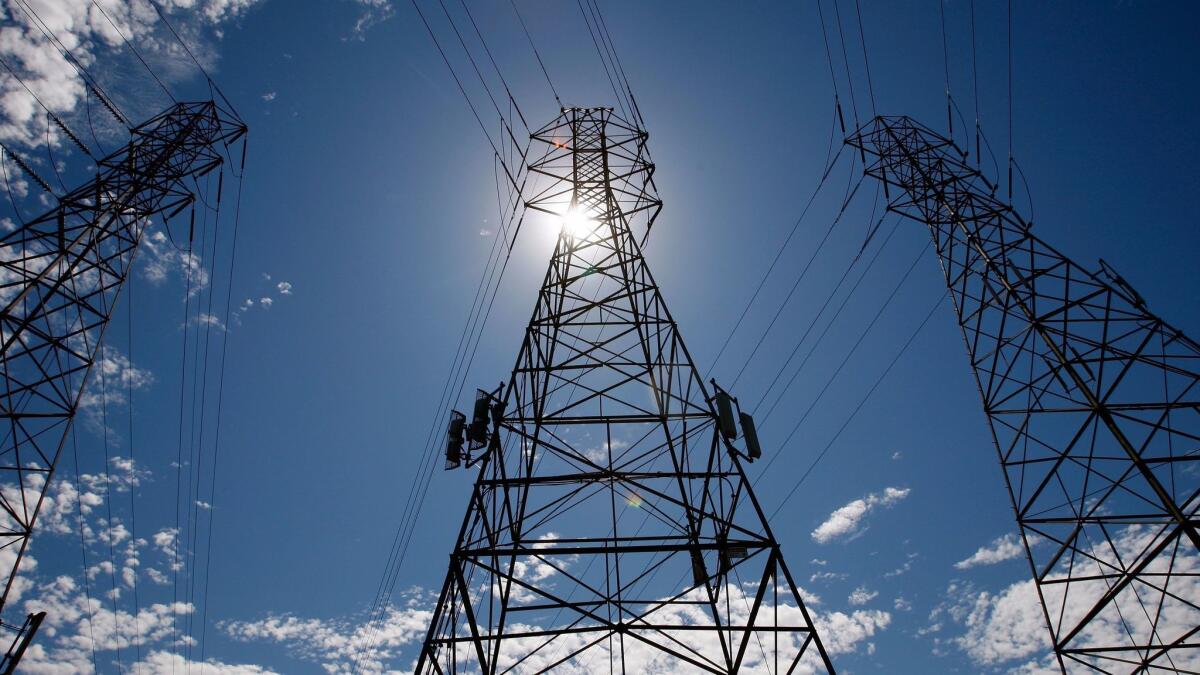San Juan Capistrano sues state regulators to block $350-million power line project

- Share via
The city of San Juan Capistrano is suing state regulators over a proposed $350-million transmission line that critics argue is just the latest in a series of unnecessary and costly utility projects.
In a 35-page lawsuit filed late Friday in U.S. District Court for the Central District of California, the Orange County municipality asked the court to stop the project, citing reports of excess power on the state’s electric grid.
The city’s initial evidence for the case includes reports in the Los Angeles Times that detailed how California regulators continue to greenlight new power plants even though the state is producing more electricity than it needs. In some cases, California is even paying other states to take excess solar power.
The lawsuit against the California Public Utilities Commission is one of a growing number of steps being taken by government leaders and ratepayers to combat energy regulators who they believe are captive to the utility industry.
Residents and officials in the Ventura County city of Oxnard have bombarded the California Energy Commission with hundreds of emails in the last couple of weeks, urging commissioners to reject a roughly $250-million natural gas plant they argue isn’t needed.
And residents in the Porter Ranch community near the Aliso Canyon natural gas storage plant have been campaigning for the permanent closure of that facility after one of the 115 wells leaked amid a nearly $200-million upgrade project. The incident, considered the worst methane leak in U.S. history, forced thousands of residents from their homes after they complained of nose bleeds, nausea and vomiting.
“The CPUC’s construction-happy, reliability-focused stance is not coincidental,” Michael Aguirre, a lawyer for San Juan Capistrano, wrote in the lawsuit against the utilities commission. “Utility companies have lobbied the CPUC into submission to approve their projects.”
The utilities commission approved the project even though an administrative law judge noted that it wasn’t necessary, Aguirre said.
In the lawsuit, he also cited comments made by Leia Guccione, an expert in renewable energy at the Rocky Mountain Institute in Colorado, to The Times.
“The way utilities earn revenue is building stuff. When they see a need, they are perversely incentivized to come up with a solution like a gas plant,” she said.
The utilities commission declined to comment on the lawsuit. It has defended its approval of natural gas plants, noting that the system needs redundancy to ensure the grid remains reliable during emergencies.
“We overbuilt the system because that was the way we provided that degree of reliability,” Michael Picker, president of the California Public Utilities Commission, told The Times in an earlier interview.
Patrick Currier, a partner with Beverly Hills-based consulting firm S2C Pacific and a former senior energy counsel to the U.S. House Energy and Commerce Committee, said the growing ratepayer angst stems from the failure of the utilities to seriously consider the impact of their actions on consumers.
Utility companies are required to maintain certain reserve margins — generally about 15% of their generation capacity — but raising rates to foot the cost of questionable new power plants will raise consumer ire, he said.
“From a ratepayer’s perspective, you never want to see overbuild,” Currier said. “Ratepayers just get stuck with the bill. They’re not going to be bamboozled again. There is a balance that needs to be struck.”
The San Juan Capistrano project would rebuild and upgrade a portion of the transmission system in south Orange County. The project, dubbed the South Orange County Reliability Enhancement project, was approved by the utilities commission in December and is expected to take more than five years to complete.
San Diego Gas and Electric Co., a subsidiary of Sempra Energy, is developing the project.
Allison Torres, an SDGE spokeswoman, said in a statement that the transmission upgrades are critical, not only for reliability of the electric grid but also for public safety.
“Once completed, this project will modernize the electric grid by rebuilding a 1950s-era substation with advanced technologies designed to strengthen the reliability of the power grid and limit electric interruptions,” Torres said. “Delivering reliable energy is vital to increasing the region’s economic growth.”
Over the last three decades the energy demand in the southern portion of Orange County has more than tripled, Torres said. That has added a strain on the power grid during peak times for customers.
The transmission upgrades would be located primarily within the cities of San Juan Capistrano and San Clemente as well as unincorporated Orange County and U.S. Marine Corps land in San Diego County.
San Juan Capistrano had long protested the project as it would require partial demolition of a historic property, threaten the environment and burden the community with years of construction.
“While some of these impacts can be mitigated, the SOCRE project will impose additional unavoidable impacts on aesthetics, biological resources, geology, soils, and mineral resources, greenhouse, hazards and hazardous material, hydrology water quality, land use and planning, noise, transportation and traffic,” Aguirre said.
For more energy news, follow Ivan Penn on Twitter: @ivanlpenn
More to Read
Inside the business of entertainment
The Wide Shot brings you news, analysis and insights on everything from streaming wars to production — and what it all means for the future.
You may occasionally receive promotional content from the Los Angeles Times.











